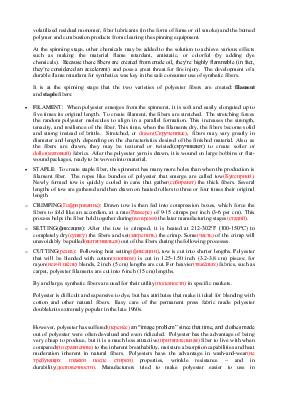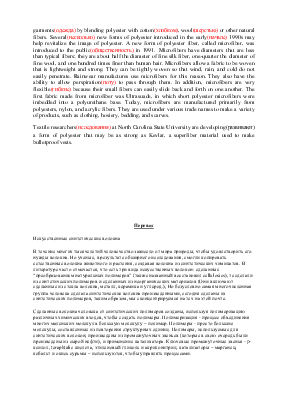







For millennia mankind depended on the natural world to supply its fiber needs. But scientists, as a result of extensive(обширного) research, were able to replicate(копировать) naturally occurring animal and plant fibers by creating fibers from synthetic chemicals. In the literature, it is often noted that there are three kinds of man-made fibers: those made by “transformation of natural polymers” (also called regenerated cellulosics), those made from synthetic polymers and those made from inorganic materials (These include the fibers made of glass, metal, ceramics and carbon.) But by far the largest group of man-made synthetic fibers being produced today are made from synthetic polymers, so we’ll concentrate on those in this post.
Man-made fibers from synthetic polymers are created using polymerization of various(различных) chemical inputs to create polymers. Polymerization is the process of combining many small molecules into a large molecule – a polymer. Polymers are simply large molecules composed(составленные) of repeating structural units. Polymers used for synthetic fibers are produced from intermediates(промежуточных) (which in turn have been produced from crude(сырой) oil) and applying a catalyst. Key intermediates are p-Xylene, teraphtalic acid, ethylene glycol and acrylonitrile; catalysts – manganese, cobalt and antimony oxide – are used to control(управлять) the processes.
Polymers are the building blocks of synthetic fibers – and of many other things. They are the basis(основание) of life and play an essential(существенную) and ubiquitous role in our everyday life, ranging from familiar synthetic plastics to natural biopolymers such as DNA and proteins that are essential for life. Natural polymeric materials such as shellac(шёлк), amber(смола) and natural rubber(каучук) have been in use(использовались) for centuries. Biopolymers, such as proteins and nucleic acids, play crucial roles in biological processes. A variety(множество) of other natural polymers exist, such as cellulose, which is the main constituent of cotton(хлопка) and wood.
Synthetic polymers include vulcanized rubber, bakelite and neoprene (and many more) in addition to polymers used in fibers: polyester, nylon, polystyrene(полистерол), polyethylene, PVC, and polyacrylonitrile (known as acrylic).
Synthetic fibers account(составляют) for about half of all fiber usage, with applications(преминением) in every field of fiber and textile technology. Four synthetic fibers – nylon, polyester, acrylic and polyolefin – dominate the market. These four account for approximately 98% by volume of global synthetic fiber production. But make no mistake(ошибку), polyester is king: polyester alone accounted for around 80% of the global market share of man-made fibers. Polyester has become the fiber of choice(альтернатывным) (sometimes blended with cotton) in garment production. As recently as 1990, world polyester production totaled 20 billion pounds. In 2002, production had more than doubled to 46 billion pounds – and was 61.5 billion pounds in 2009. Polyester fiber consumption(потребление) increased at an annual growth rate of 6.2% between(между) 1998 and 2008, although(хотя) demand(требования) has recently moderated as a result of the global economic slowdown.
Synthetic fiber production has definitely moved to Asian countries. As stated(указано) in Textile World : “the critical mass of fiber manufacturing from the industrialized West to the developing East is a study in comparative(сравнительной) economics and social realities.” In 1990, China represented barely 8% of total man-made production; by 2002 it produced almost 30%. India is also making a pitch to be a player: From a virtually nonexistent position(положения) in 1990 to currently 5%, with programs in place to expand this further. According(следуя) to Textile World, the world of polyester production
Уважаемый посетитель!
Чтобы распечатать файл, скачайте его (в формате Word).
Ссылка на скачивание - внизу страницы.